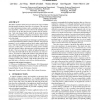Free Online Productivity Tools
i2Speak
i2Symbol
i2OCR
iTex2Img
iWeb2Print
iWeb2Shot
i2Type
iPdf2Split
iPdf2Merge
i2Bopomofo
i2Arabic
i2Style
i2Image
i2PDF
iLatex2Rtf
Sci2ools
IEEEPACT
2006
IEEE
2006
IEEE
A low-cost memory remapping scheme for address bus protection
The address sequence on the processor-memory bus can reveal abundant information about the control flow of a program. This can lead to critical information leakage such as encryption keys or proprietary algorithms. Addresses can be observed by attaching a hardware device on the bus that passively monitors the bus transaction. Such side-channel attacks should be given rising attention especially in a distributed computing environment, where remote servers running sensitive programs are not within the physical control of the client. Two previously proposed hardware techniques tackled this problem through randomizing address patterns on the bus. One proposal permutes a set of contiguous memory blocks under certain conditions, while the other approach randomly swaps two blocks when necessary. In this paper, we present an anatomy of these attempts and show that they impose great pressure on both the memory and the disk. This leaves them less scalable in high-performance systems where the ...
Contiguous Memory Blocks | Hardware | IEEEPACT 2006 | Processor-memory Bus | Such Side-channel Attacks |
| Added | 11 Jun 2010 |
| Updated | 11 Jun 2010 |
| Type | Conference |
| Year | 2006 |
| Where | IEEEPACT |
| Authors | Lan Gao, Jun Yang 0002, Marek Chrobak, Youtao Zhang, San Nguyen, Hsien-Hsin S. Lee |
Comments (0)

